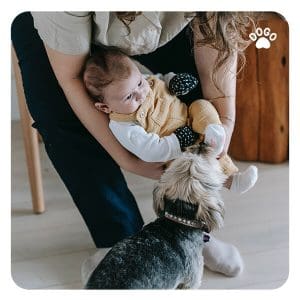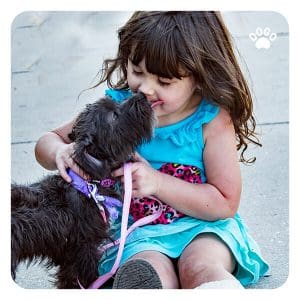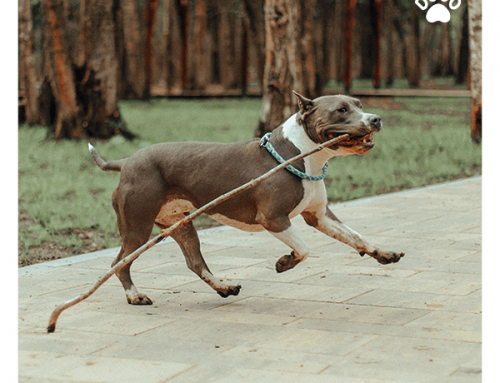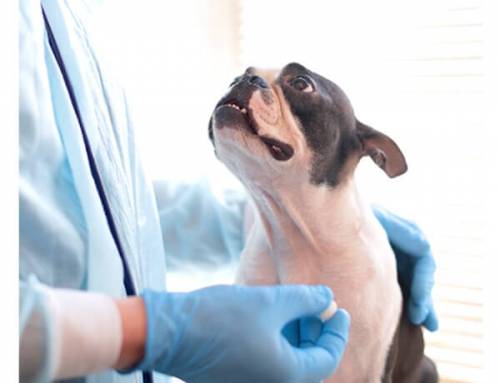
Prepare Your Dog for Baby Armageddon
It’s been known for a long time that prevention works wonders. It helps to avoid any complications. So why is it forgotten in such cases? The arrival of a new baby in the house is a significant event. It is associated with many, sometimes even extreme emotions – including joy, uncertainty, and stress. It is a big change not only for new parents but also for their dogs. In fact, the living arrangements of ALL household members are changing. You, as a parent, understand the situation. You’ve had as long as nine months to get used to the idea. That’s a lot of time to establish a new routine. It makes it much easier for you to find your way into the new reality. But how does the situation look from your dog’s perspective? We are about to explain!
A Dog’s Perspective

…. she brought some little man with her! I do not understand! Why do we need him!? He is constantly crying, loud and annoying! Ever since he showed up, my parents have been giving me food at different times of the day, forgetting to go on walks together, skipping cuddles on the couch, and not letting me into OUR bedroom. All because of this baby behemoth, I don’t like him!
Do you understand now?
Your dog will be confused, stressed, and family member arrives at home.
You can, for example:
* teach your dog not to sleep in the bedroom by offering them a kennel crate or their own bed in a more private part of the house, isolated from the crying baby;
* implement new habits on walks, with particular emphasis on walking on a “loose leash”;
* familiarise your pet with noise – for example, you can play the sound of a crying baby on your phone. Before you do this, give your dog a chew or organize a sniffing game. Your dog should engage in this while the recording is playing. It will help them begin to associate the annoying sound with an activity that is calming and fun. Remember to start with a quiet recording. Over time, gradually increase the volume;
* introduce the dog to the baby’s things – for example, you can show the dog the baby’s nappies, clothes, and toys. Let them sniff, praise them for it. These objects must stop being strange and disturbing to your dog. Let them become an everyday part of life.
If you prepare your life for your baby’s arrival, you will avoid a lot of unnecessary stress. Emotions and changes will happen anyway. Your dog will sense them, and it will be difficult for them at first. If you make some changes beforehand, you won’t disturb your pet’s sense of security as much. Plus, if the dog doesn’t associate the new rules with the baby, it will be easier for them to accept the toddler.
However, just preparing your dog for the arrival of a new baby is not enough. You should also consider how your dog will react to the baby’s presence. For instance, if your dog has never been around babies, it is crucial to introduce them gradually. You can start by holding the baby in your arms and allowing your dog to sniff around. Make sure to keep your dog on a leash and monitor their behavior closely. If your dog seems anxious or aggressive, it is best to remove them from the situation and try again later. It is also important to teach your dog basic commands such as “sit” or “stay” to help them obey your instructions around the baby.
2. Take Care of Your Dog’s Needs
After the arrival of a baby in the house, you should invariably take care of your dog’s needs. Whether or not you have previously prepared them for the changes that have occurred. If you neglect your dog’s needs, you will increase the risk of them becoming agitated, frustrated, nervous, and aggressive. It spells disaster!
So what to do to avoid this? The best solution is to keep an eye on your pet’s current routine. The more you disrupt it, the more you disrupt your pet’s emotional stability.
One way to take care of your dog’s needs after the arrival of a new baby is to maintain their exercise routine. Dogs need physical activity to stay healthy and happy. It is essential to take your dog for regular walks or runs, even if it means waking up earlier or adjusting your schedule. You can also engage them in interactive games such as fetch or hide-and-seek to keep them mentally stimulated. Another way to take care of your dog’s needs is to provide them with a comfortable and quiet space where they can retreat when they need a break from the chaos. This can be a crate, a bed, or a room where they can relax and recharge.
Basic rules for a healthy dog-baby relationship
- Your dog DOES NOT have to agree to everything.
- The toddler MUST respect the dog’s comfort zone and space.
Every pet has their boundaries that should not be violated. However, do they have the right to react aggressively and dangerously to those around them when they are crossed? Is a young child capable of understanding and respecting these boundaries? What is your role in this process?
What needs does your dog have?
* walks – the right amount and quality of exercise;
* food – the correct quantity and quality of meals at consistent times throughout the day;
* chewing and sniffing – providing your dog with chews and sniffing games to help reduce the level of excitement;
* play – will help relieve stress, reassure the dog that they have not been rejected in favor of a new family member;
* mental work/learning – such as obedience training or playing with interactive toys. Learning tires the mind, while completing a task gives satisfaction and increases the dog’s self-esteem;
* sleep – the right amount and quality of sleep helps calm and regenerate the body and reduce stress levels.
If you don’t have the ability to handle your dog’s needs on your own, ask friends or family for help.
3. Ensure a Proper Dog-Baby Relationship
Suppose you have survived the newborn period and the baby is becoming a toddler, starting to walk and seek interaction with the dog. In that case, it’s time to step in. The dog and the baby will coexist, so you need to make it a good life for them. You are an adult and already know how to interact with your pet. You know what annoys, irritates, and stresses them and what to avoid. A toddler does not have this knowledge yet. Your task is to teach them this.
Your job is to:
Keep an eye on your child to make sure they don’t enter the dog’s space.

Teach your dog to respond appropriately to the situation.
Teach your dog to use their space if they don’t like something. Show them that instead of growling and barking, they can back off and walk away without provoking conflict. Provide them with their own space in the house. Let it be a private area when no one ever disturbs them. The child should not have access to it. Make this place give the dog a sense of peace and security. It is where your pup should go when they need to isolate themselves from the household chaos. You can introduce a kennel cage into your dog’s life. If you don’t know how to do this, take a look in the DOGO app! You will find a detailed description of how to encourage your dog to spend a peaceful time in the crate.
Can a Baby and a Dog in the House Get Along?
Now you know that a baby and a dog can get along! First, however, they need to be taught to cooperate, understand and respect each other. If you take solid care of this process, family life will become easier and much more pleasant. Good luck!
Create a Personalized Training Plan for your Dog






